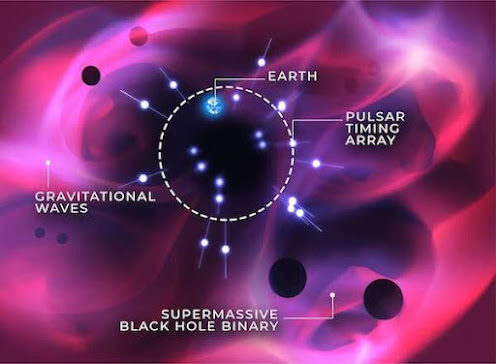When black holes and other enormously massive, dense objects whirl around one another, they send out ripples in space and time called gravitational waves. These waves are one of the few ways we have to study the enigmatic cosmic giants that create them.
Astronomers have observed the high-frequency "chirps" of colliding black holes, but the ultra-low-frequency rumble of supermassive black holes orbiting one another has proven harder to detect. For decades, we have been observing pulsars, a type of star that pulses like a lighthouse, in search of the faint rippling of these waves.
Today, pulsar research collaborations around the world—including ours, the Parkes Pulsar Timing Array—announced their strongest evidence yet for the existence of these waves.
What are gravitational waves?
In 1915, German-born physicist Albert Einstein presented a breakthrough insight into the nature of gravity: the general theory of relativity.
The theory describes the universe as a four-dimensional "fabric" called spacetime that can stretch, squeeze, bend and twist. Massive objects distort this fabric to give rise to gravity.A curious consequence of the theory is that the motion of massive objects should produce ripples in this fabric, called gravitational waves, which spread at the speed of light.
It takes an enormous amount of energy to create the tiniest of these ripples. For this reason, Einstein was convinced gravitational waves would never be directly observed.
A century later, researchers from the LIGO and Virgo collaborations witnessed the collision of two black holes, which sent a burst of gravitational waves chirping throughout the universe.
Now, seven years after this discovery, radio astronomers from Australia, China, Europe, India, and North America have found evidence for ultra-low-frequency gravitational waves.
A slow rumbling of gravitational waves
Unlike the sudden burst of gravitational waves reported in 2016, these ultra-low-frequency gravitational waves take years or even decades to oscillate.
They are expected to be produced by pairs of supermassive black holes, orbiting at the cores of distant galaxies throughout the universe. To find these gravitational waves, scientists would need to construct a detector the size of a galaxy.
Or we can use pulsars, which are already spread across the galaxy, and whose pulses arrive at our telescopes with the regularity of precise clocks.
CSIRO's Parkes radio telescope, Murriyang, has been observing an array of these pulsars for almost two decades. Our Parkes Pulsar Timing Array team is one of several collaborations around the world that have today announced hints of gravitational waves in their latest data sets.
Other collaborations in China (CPTA), Europe and India (EPTA and InPTA), and North America (NANOGrav) see similar signals.
The signal we are searching for is a random "ocean" of gravitational waves produced by all the pairs of supermassive black holes in the universe.
Observing these waves is not only another triumph of Einstein's theory, but has important consequences for our understanding of the history of galaxies in the universe. Supermassive black holes are the engines at the heart of galaxies that feed on gas and regulate star formation.
The signal appears as a low-frequency rumble, common to all pulsars in the array. As the gravitational waves wash over Earth, they affect the apparent rotation rates of the pulsars.
The stretching and squeezing of our galaxy by these waves ultimately changes the distances to the pulsars by just tens of meters. That's not much when the pulsars are typically about 1,000 light-years away (that's about 10,000,000,000,000,000,000 meters).
Remarkably, we can observe these shifts in spacetime as nanosecond delays to the pulses, which radio astronomers can track with relative ease because pulsars are such stable natural clocks.
International Conference on Gravitational Waves
visit:gravity.sfconferences.com
Nomination link:https://x-i.me/granom
#GravitationalWaves #SupermassiveBlackHoles #AstronomyDiscoveries #Astrophysics #BlackHolePairs #CosmicRipples #SpaceExploration #ScientificBreakthrough #LIGO #Virgo #EinsteinWasRight






No comments:
Post a Comment